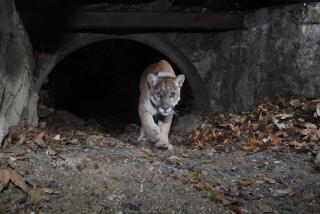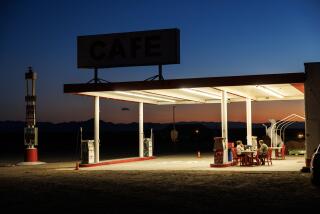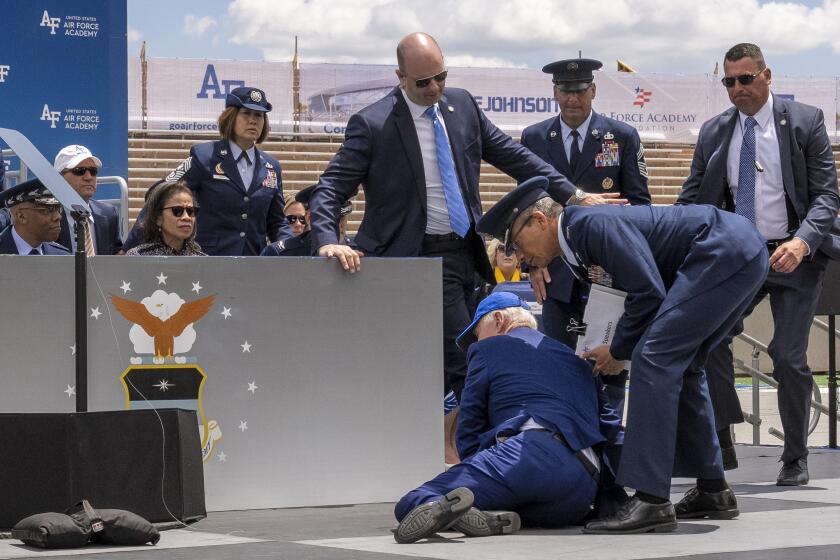Echo of ‘Born Free’ : Adamson--Call of Wild Still Roars
- Share via
KORA NATIONAL RESERVE, Kenya — East Africa once abounded with legendary specimens of willful individualism, men and women who went their own ways, followed their own instincts and said to hell with what other people thought of them.
There are not many of these characters anymore. Africa’s political independence, the advancing forces of modernity, the lengthening reach of government bureaucracy--all have helped to drive such people to ground, to retirement, to their memories and memoirs.
The spectacle of George Adamson, 80 years old and still out in the raw African bush with wild creatures eating out of his hand, seems to offer some mild, possibly temporary assurance to those who fear the extinction of this old style of untrammeled spunk. If some people think--and some do--that Adamson is a little bit nuts, well, it’s no skin off his deeply tanned back.
Doing What He Wants
“I’m doing what I want to be doing,” he says, taking a contented draw on his pipe as he offers a peanut to the squirrel sharing his luncheon table.
Adamson still lives in a thatched-roof house in this remote corner of Kenya’s bushland, a 500-square-mile reserve of tangled thorn and jagged comifora trees. He still tends his lions. He passes his days feeding his tame birds and squirrels, tossing camel meat to the lions and amiably tolerating a steady stream of wildlife buffs and nature pilgrims who make the trek to his camp less to view the wild game, which is more easily visible at a dozen other locations in Kenya, than to get a look at the man himself.
For it is George Adamson who represents the truly endangered species of Kora.
Wife Wrote Best-Seller
Adamson’s name is familiar to those who recall the 1960 best-seller “Born Free,” an account written by Adamson’s late wife, Joy, of their successful struggle to return their pet lioness, Elsa, to a life in the wild. The book spawned two others (“Living Free” and “Forever Free”), a popular movie and a treacly hit song that quickly became a standard of Las Vegas crooners and high school choruses.
All that seems a long time ago, and in more recent years, Adamson has taken his place as one of the true eccentrics of the country, the man with the controversial--not to say Quixotic--notion of returning tamed lions to their natural wilderness habitat.
He is a man with scores of friends, all of whom treat him with a sort of proprietary protectiveness, seeing to it that planes flying up to the landing strip hacked out of the rough Kora bushland carry fresh supplies of food and drink. The stream of visitors is endless and many of his closest friends seem to feel that Adamson may be done in more by the strain of having so many guests than by the rigors of the bush or the lions that live around the fenced enclosure where he makes his home.
And yet Adamson welcomes all, emerging from his one-room house with a smile and a firm handshake. He dresses in baggy shorts and sandals, and his white hair reaches almost to his bare shoulders.
“Would you like some lunch?” he asks.
Along with four African helpers, Adamson lives at Kora with his brother, Terence, 78, who suffered a stroke last year and complains bitterly that his legs “are just damn useless anymore.”
The lions do not usually appear until late in the afternoon. There is Koretta, a third-generation Kora lion, about 8 years old, five of her 3-month-old cubs, and two of her older female cubs, about 18 months old. Altogether, about a dozen lions are believed to live in the reserve, all but a few of them offspring of the 16 lions that George Adamson has returned to the wild here in the past 15 years.
“There isn’t much game for the lions around here now,” Adamson explains. “It was pretty much wiped out by the drought last year. Koretta would have a pretty hard time surviving with those cubs unless I gave her some food.”
Two Cubs Enter Camp
In the late afternoon, the two older cubs approach the camp, in their slow, regal gait, from opposite directions. Koretta, her five scampering cubs tumbling behind her, appears out of the tall grass and thorn trees at the foot of the towering rock that looms up in front of Adamson’s compound.
Adamson opens the gate and from a bucket tosses the cats chunks of camel meat. The lions maul it about in the dirt, then settle down under the trees to eat. Adamson and his guests, a reporter and four weekend visitors from Nairobi, sit for tea, prepared by the African cook, and watch.
George and Terence Adamson were born in India of British-Irish parents and in 1927 came to Kenya, where their father tried, and failed, to run a coffee farm. After a few years in various unsuccessful business ventures, George became a Kenya game warden.
George and his wife separated in 1970. (In 1980, Joy Adamson was killed, by one of her African workers at her Kenyan camp, where she also worked with lions.)
Adamson worked as a technical adviser on the film “Born Free” and later took three of the lions used in the movie and set them free in Meru National Park. When one of the lions mauled the game warden’s son, Adamson was asked to leave.
By this time, Adamson had retired from the Kenya Wildlife Department, which had employed him for 25 years, and in 1970 he rented the 500 square miles of Kora from the Tana River County Council and moved his operations here. Since then, the Kenyan government has turned the area into a wildlife reserve and has allowed Adamson to stay on as a sort of unofficial resident warden.
He lives on his pension of about $700 a month, plus about $600 a month from his wife’s estate. Out of those funds and the modest donations received by the Kora Wildlife Preservation Trust (set up in the United States, Britain and West Germany), Kora manages to keep functioning.
Skeptics Cite Danger
It has not been easy, or without controversy. Some wildlife experts have long been skeptical of Adamson’s program, arguing that no lion is as dangerous as a lion that has become accustomed to close contact with humans. Such lions, they argue, lose their fear of man and are, in fact, more likely to attack. Lions that have been fed by man, they say, are also more likely to attack domestic livestock, thereby encouraging herdsmen to destroy the lions for feeding on their animals.
The critics (some of whom have known and liked Adamson for years and are reluctant to voice their criticisms publicly) were given ammunition by several incidents around Adamson’s camp. Shortly after Adamson moved to Kora, one of his African assistants was killed by the same lion that had mauled the game warden’s son at Meru. It was the third attack involving that lion, named Boy (a star of the “Born Free” movie), and Adamson was forced to shoot it.
Six years ago, Terence was badly mauled by another lion. After that, the Wildlife Department halted Adamson’s release program. Koretta and her cubs, in effect, are the end of the line of Adamson’s lions at Kora.
Lions Not Man-Eaters
Adamson acknowledges the criticism but argues that his program has been a success. None of his lions, he points out, has attacked a stranger; in other words, they have not gone on to become man-eaters but have proved a danger only to the people who have worked around them and, perhaps, become careless about their presence.
In any event, he feels vindicated by his efforts. Although no one is really sure how many lions there are in the Kora reserve, those that Adamson has brought in seem to have bred with lions already living in the reserve.
“Male lions move around a lot,” Adamson says. “Some of them seem to stay around a while and then move on. They disappear for a while and then come back. The females are more likely to stay around where they grew up, although they sometimes go away for extended periods of time.” Toward the end of their lives (lions in the wild usually live 10 to 12 years) the females, Adamson has learned, often go off on their own as well.
Although he is resigned to the end of the lion-release program, he is hopeful that his ideas will endure. Adamson’s assistant, Tony Fitzjohn, who began working at Kora in 1970, has branched out on his own with a program for leopards modeled on Adamson’s with the lions.
Fitzjohn’s first two leopards, male and female cubs, came from a restaurant owner in Paris. A third, a male, now about to be released from Fitzjohn’s camp a few miles from Adamson’s, was an orphaned cub found on the farm of Saudi millionaire Adnan Khashoggi, near Nanyuki, Kenya. The leopard, now 18 months old and fully grown, is kept in a pen in Fitzjohn’s camp, where it dozes atop its cave, constructed from local rock, and growls softly at strangers.
Program for Leopards
Fitzjohn is fighting hard to see that the leopard program continues in Kora. He has traveled to Europe and the United States to raise money (Kora Wildlife Preservation U.S.A., Inc., is situated in Santa Monica) and is hoping that his work will lead to the establishment of a viable leopard population within the reserve.
Fitzjohn, 40, seems to be well on the way to creating as much of a legend for himself as Adamson has, in a different but complementary manner. He once portrayed a Tarzan-like figure in a Japanese movie filmed at Kora and the image seemed to fit Fitzjohn perfectly--the “Wild Man of Kora,” some people called him--muscular, bare-chested, handsome and crazy enough to take midnight swims in the crocodile-infested waters of the Tana River. Visitors to his camp, particularly young women, came away enthralled.
“We’ve had some great times, George and I,” Fitzjohn says. “You wouldn’t believe it. No one would believe it. Wonderful times.”
A tone of nostalgia creeps into Fitzjohn’s voice when he talks of their early years together or of the hard financial times when the two of them survived for weeks on old army field rations and when there was never any money for gasoline to keep their beat-up Land Rovers running.
But, for all that time, they were able to walk through Kora’s virgin wilderness, tracking lions, camping under the African sky while George imparted to his acolyte the lore accumulated from 50 years spent in places just like this. The sort of adventure that rich men spend thousands of dollars to experience on vacations, they had every day.
Depends on Contributions
Both Adamson and Fitzjohn admit that it does not seem likely that there will be room for many more people like them in the future of Africa. Fitzjohn, as intense a man as Adamson is relaxed, is already under treatment for a duodenal ulcer, a condition given little relief when he is forced to put on a necktie and go to Nairobi to deal with government officials and court favor with those in a position to donate money for Kora’s preservation. With money from the Kenyan government in short supply, the continued operation of Kora is likely to depend on outside contributions for some time to come. It takes more than a Tarzan image to survive.
And yet those efforts lead back to the same goal--to remain in the wilderness with the animals. As Fitzjohn says, “It beats the hell out of living in town.”
That, after all, was Adamson’s original impulse.
One evening, a visitor asked Adamson what had brought him to Kora: Was it for himself, or for the animals?
“For myself, first,” he replied, without hesitation. “Then for the animals.”
The planet Jupiter was rising behind the big rock next to the camp, two of its moons clearly visible through field glasses. Just outside the compound, three generations of Kora lions gnawed at the carcass of a camel. The five cubs, now about the size of cocker spaniels, tumbled over one another in the dust, now and then provoking a good-natured backhand cuff from the older lions. Dottie, a pet raven, landed atop the fence for a final evening visit, then dropped down to the table to search for a stray cracker.
Knack for Story-Telling
Half a dozen guests settled around the table, watching the emerging stars and prompting Adamson to talk of his adventures in the wild. Adamson has the knack of telling stories with economy and grace, even though he must have recited them hundreds of times. But he offers them only in response to questions. He is quite content to sit silent, either listening to others or simply, as Fitzjohn says, “tuning out.”
“Bored?” Adamson says. “Oh no, I’m never bored. This is what I want to do. I’ve always liked this, being off by myself.”
The people listening to him laugh, for it is a sort of joke about Kora that there are always visitors, always a small planeload of weekenders from Nairobi or minor celebrities from faraway countries, descending on Kora to sit around the table and listen to George and watch the lions.
“I don’t mind people coming up here,” Adamson goes on. “Mst of them are very nice people and they’re interested in our work. I don’t think we’ve ever had more than a couple that we wouldn’t invite back.
“When I was younger, I used to go off for days at a time and not see anyone. I quite liked that sort of thing. Even now, during the rainy season, there are periods of time when we don’t have any visitors. I don’t mind that, either. There is always lots of work to do.”
More to Read
Sign up for our Book Club newsletter
Get the latest news, events and more from the Los Angeles Times Book Club, and help us get L.A. reading and talking.
You may occasionally receive promotional content from the Los Angeles Times.










